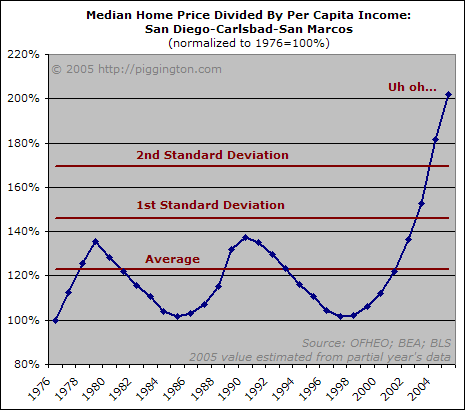It is often argued, usually by real estate permabulls, that there is widespread concern about a decline in home prices. This pessimism is routinely blamed for the slowdown we’ve seen in sales and price growth. "Ask a real estate agent today," sputters George Chamberlin in a recent North County Times rant, "and they will tell you clients want to wait until prices drop 20 percent before they buy a new house."
This is, of course, entirely untrue. The typical San Diegan thinks things may flatten out for a while, but very few people are expecting prices to decline in a significant manner. And as Mr. Chamberlin himself points out, home sales haven’t slowed down all that much in the grand scheme of things. If everyone were expecting a 20% price drop, why would anyone be buying at all?
Nope, the man on the street is feeling pretty confident, and he is not alone in his sanguinity. As today’s Union-Tribune informs us, the panel of real estate analysts at USD’s Outlook 2006 housing conference was nigh bursting with good cheer. Remember these choice quotes in the years ahead:
- "We may see a decline in sales but not prices." – Louis A. Galuppo, director of USD’s Burnham-Moores Center for Real Estate
- "[T]here are no major economic triggers, such as massive job losses, to cause the housing market to crash." – Joe Anfuso, chief financial officer of Shea Homes San Diego
- "We may see a blip up in foreclosures and delinquencies." – Leslie Appleton-Young, chief economist for the California Association of Realtors
- "I think we’re in for a soft landing." Leslie Appleton-Young, again
Ah, the beloved soft landing. I think I’ll start capitalizing the phrase in an attempt to denote its cherished and iconic status.
Soft Landing.
Yes… I like that very much indeed.
Legendary investor Jeremy Grantham recently had his research staff compile info on all the historical stock, currency, and commodity bubbles they could find. A "bubble" was defined here as a two-sigma event: an asset price that got more than two standard deviations away from its historical trend. Grantham and company identified 28 financial bubbles, of which every one—every single one—saw prices revert back to the mean. So where does San Diego fit into all this?

Of course, there is more to any story than deviations from the mean, but the point here is that history is telling us something. People can make all the excuses and rationalizations they want, but the fact is that markets revert to the mean. Bubbles burst.
People continue to tell themselves (and anyone else who will listen) that San Diego real estate will be the history’s first asset to rise so far, so fast, and never come back down to earth. They will eventually be relieved of this misconception. For now, though, faith in the Soft Landing holds sway.
